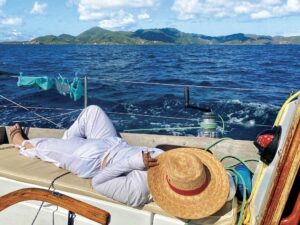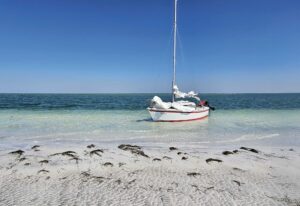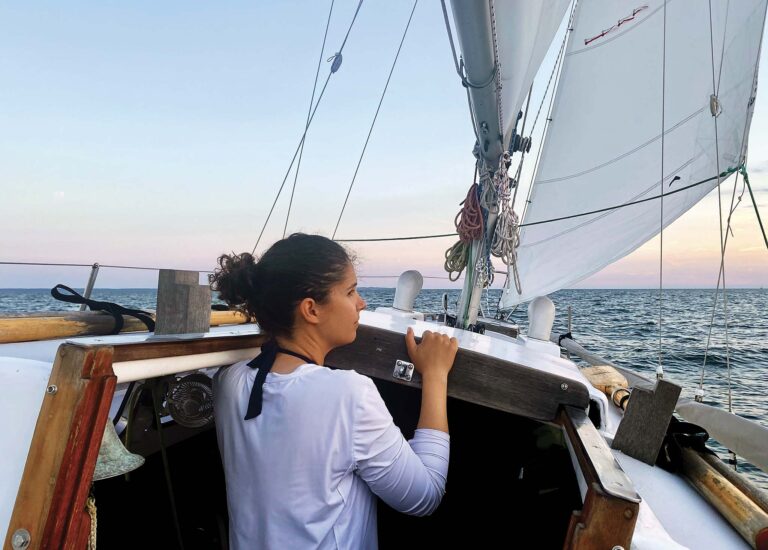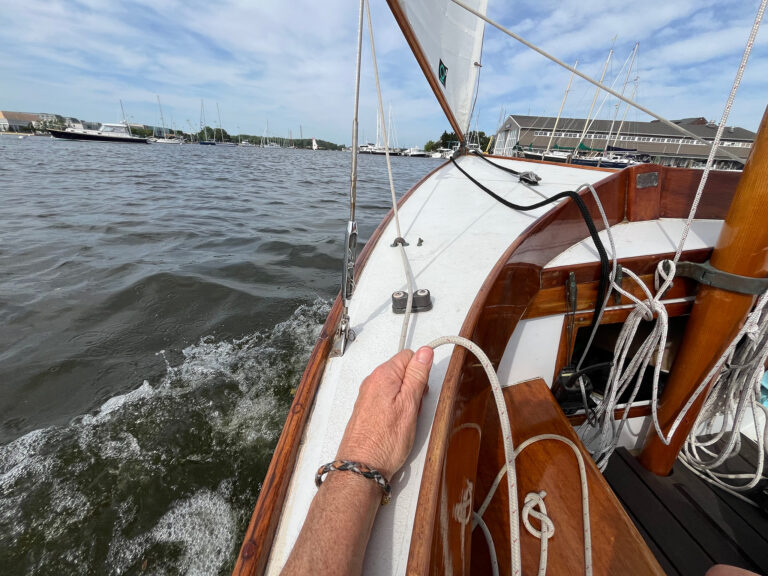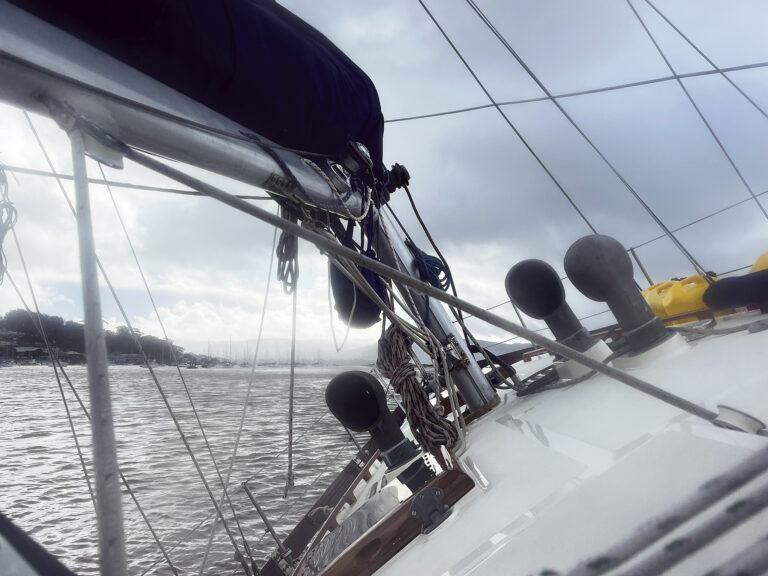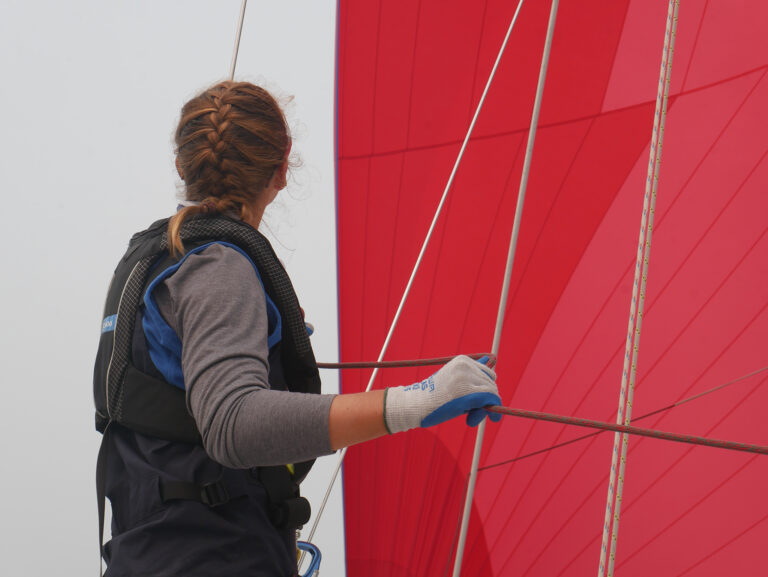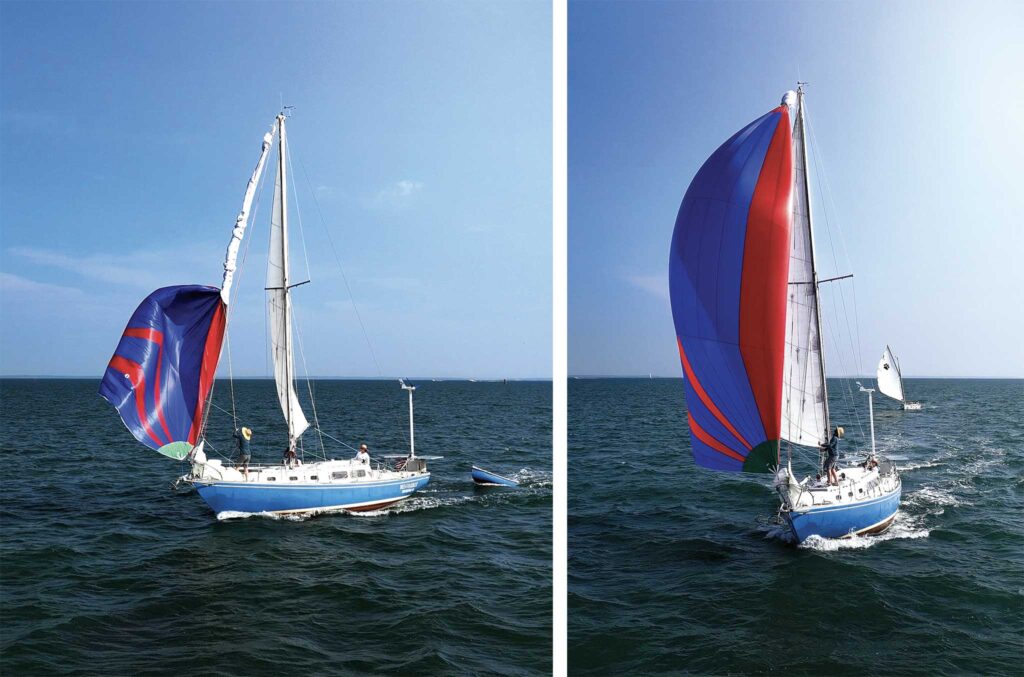It was early November, I was singlehanded and about 150 miles south of Bermuda, heading south. I had dealt with breeze hard on the nose for a few days, but between a slow shift and finally making enough eastward progress to turn south, I was off the breeze and enjoying a northeasterly.
As I closed in on the U.S. Virgin Islands, the trades would fill in from the east and build. For now, it was light and on the stern quarter. The flat water made up my mind for me. I set my asymmetrical spinnaker and picked up another couple knots of speed. I went about reading, cooking, and enjoying the beautiful day. When the wind followed the prediction, I strolled up to the foredeck, doused the spinnaker, hoisted the jib, and continued on course.
Granted, I have a lot of time and miles in my Luders 33, Ben-Varrey, experience that makes decisions about spinnakers—which for some sailors can be one of the more intimidating sails in the sailplan—fairly straightforward. So does the fact that at 33 feet, the boat is eminently manageable for one or two people.
But regardless of what you’re sailing, handling a chute shouldn’t need to be difficult; with limited strategy, some specialized equipment, and a bit of practice, it can be straightforward to fly a spinnaker while shorthanded.
And it’s worth it to learn. Sailing is simply more fun when we can keep moving quickly in light air with the help of a spinnaker. It’s also a blast to push towards new speed records in pressure. We all have our thresholds, metered by our various levels of adrenaline addiction, but what typically doesn’t vary is how often we find ourselves sailing shorthanded or with a limited amount of experienced crew. Flying that kite doesn’t need to feel out of reach.
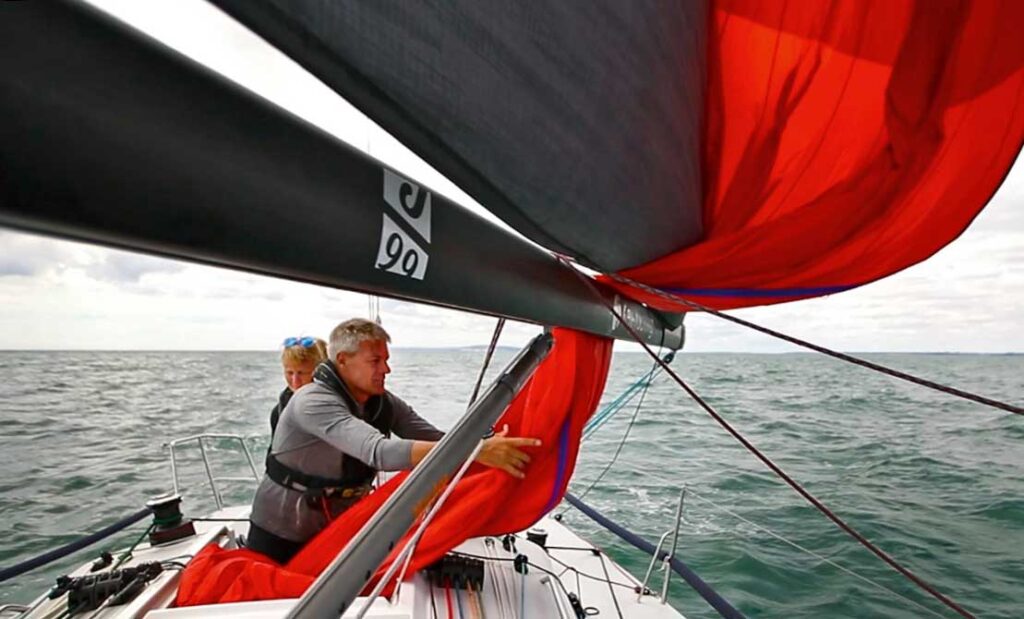
Socks
If a spinnaker is hoisted but has no way to fill, it’s manageable. A spinnaker sock, which is a long tube of nylon fabric, does exactly that by containing the kite.
The bottom end of the sock has a hard collar that matches the diameter of the nylon fabric tube. That collar is raised by a line that leads inside the sock, turns around a block just above the head of the spinnaker, and then runs down and outside to the deck. The bitter end is secured to the bottom of the hard collar, with plenty of slack in its length. Pull on one end to lift the sock and set the spinnaker; it all just scrunches up above the head of the spinnaker. Pull the other end to lower the sock and douse the spinnaker.
The sock becomes a part of each spinnaker assembly, with one sock required for each spinnaker onboard. This is one of the simpler approaches to allow a shorthanded crew to make relaxed sets and douses. There are some nuances; for example, the sheet must be eased to fully douse the spinnaker. Sometimes, you have to play the lines a little to ensure the collar doesn’t get bogged down in a wad of spinnaker inside the sock. Also note that the sock control line should be secured to the boat (I prefer a cleat on the mast) to ensure it can be reached when needed, otherwise it tends to fly away from the boat with the spinnaker.
The tack line (or guy, if flying a symmetrical chute) and halyard are all pre-set before raising the sock. This means the only two lines to focus on are the spinnaker sheet and the sock control line when ready to set. When singlehanding, I preset the sheet on a winch with a small amount of tension (to help avoid twists), and as soon as the sock is raised, I can walk back to the cockpit and fully trim.

Keeping an A-sail’s tack low helps provide better control of the sail and reduce the risk of collapsing.
Photo by Connor-Bailey
Furlers
A more recent innovation is the adaptation of the continuous furler, made possible by the advancement of materials, notably in handling torsion. Similar to the sock, this specialized system allows a spinnaker (asymmetrical only, in this case) to be hoisted fully furled and then set or doused without touching the halyard again.
Each spinnaker is fit with a dedicated torsion cable/rope and upper and lower fittings (note that structured luffs are a growing alternative to torsion cables/ropes). The furling drum can be a part of this assembly, or with quick-connect fittings, multiple spinnakers can share the same continuous furler.
An endless furling line runs aft for control from the cockpit. Pulling the sheet, with an eased furling line, sets the spinnaker. To douse, ease the sheets while pulling on the furling line. Either process is made easier by heading off the wind to decrease loads. Functionally, curved luffs are furled from the top-down, whereas straight luffs (think code zero) can still use a traditional bottom-up approach, but that has little impact on using the equipment.
Traditional Approaches
Before any of the aforementioned equipment existed, bands were popular to delay spinnakers from filling during a set (notably yarn loops or rubber bands). While no one advocates for this method anymore, since that debris that falls into the water, there is a modern approach to this thinking: Zippers can be sewn into the spinnaker. The zippers must be zipped when packing the spinnaker and then they separate as the spinnaker fills and is trimmed.
This still doesn’t solve easily dousing though. And what if something goes wrong with a sock or furler? And can a spinnaker still be flown shorthanded without any specialized equipment?
Regardless of the setup, setting a spinnaker shorthanded is much easier when apparent wind levels are light. Start by heading off the wind, even if intending to fly the spinnaker on a reach (make sure the boom preventer is hooked up). And, since this isn’t a racing scenario, furl or drop the headsail before beginning any spinnaker work. This will increase visibility and make it easier to work on the foredeck. With this modification to the sailplan, the balance of the boat will also change, so take it one step at a time–under just the main, make sure the autopilot and mainsail trim don’t need to be adjusted to keep a steady course.
Without a sock or furler, spinnaker hoists should be intentional and reasonably quick, using the mainsail to blanket the spinnaker. A slow hoist is likely to result in a twist (a tug on the leech can often undo one, maybe two, twists once hoisted). Trim on as soon as you’ve achieved a full hoist. If using traditional hoists and douses, it’s often best to avoid flying spinnakers on breezy days to keep shorthanded operations manageable.
Douses provide more opportunity for creativity. In a shorthanded situation where equipment fails or when it doesn’t exist, I prefer a letterbox drop. A lazy sheet is led from the clew of the spinnaker inboard and between the boom and the foot of the mainsail (this slot acts as an extra set of hands to control the douse), then down the companionway. A deep dive downwind depowers the spinnaker, and the tack (or guy) can be blown. Pull the lazy sheet from below deck, quickly easing the halyard initially, and the spinnaker will follow right into the cabin from leeward. In a rougher sea state limit how deep the boat sails when dousing to not tempt an accidental jibe.
This technique is great, but if you have a mainsail in a StackPack-type system or one that’s not loose-footed, it’s not doable. A leeward drop is the next best option. Take the lazy sheet and lead it down the forward hatch or companionway. With one crew standing on the foredeck or by the companionway, with that lazy sheet in hand, sail deep, letting the main cover and collapse the spinnaker—easing the guy too will help with a symmetrical kite. Blow the sheet and tack (or guy). Pull the spinnaker inboard and stuff it down the hatch as the halyard is controlled from the helm, or at the mast with an autopilot on.
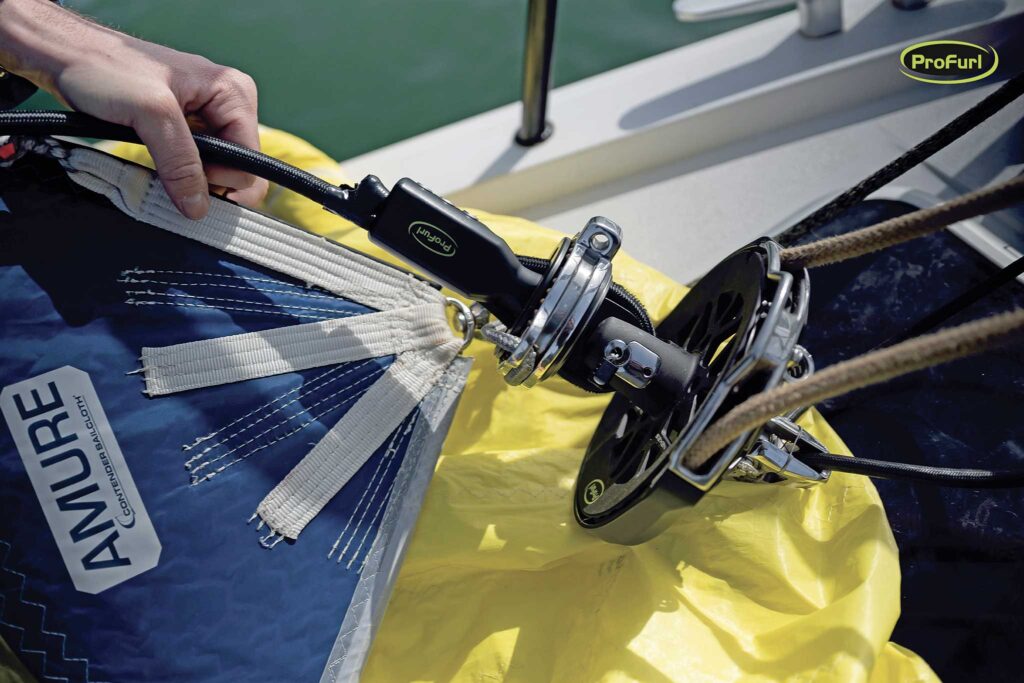
A continuous furler, like the Profurl Spinex Top Down furling system below left, makes handling A-sails a breeze.
Photo courtesy of Wichard
Trimming
Cruising asks for a stable sailplan. It’s a tradeoff with boat speed but allows us to rest and focus on other tasks. We accomplish that stability with a spinnaker by slightly over trimming.
In the case of a symmetrical spinnaker, square the pole perpendicular to the wind, as normal. Then the strategy is the same for an asymmetrical or a symmetrical spinnaker. Ease the sheet until the first windward panel of the spinnaker begins to curl and then trim until that panel is no longer curling. This provides some margin of error for minor changes in wind velocity and direction. Over trimming even more can help if conditions become more variable, but there is a limit before the main will blanket the spinnaker and cause it to collapse. Maintain a balance. In some erratic conditions, active trimming or a sail change are the only options.
Easing the tack line of an asymmetrical spinnaker can help project it to windward farther, increasing speed, but it comes at the cost of sail stability. Consider keeping the tack of the spinnaker lower to reduce adjustments and the risk of it collapsing.
Twings, on the other hand, can help stabilize both a symmetrical and asymmetrical kite. These are lines that secure to a floating block or ring on the spinnaker sheets and lead back to the boat amidships, often through a fairlead and to cam cleats. They can even be rigged up temporarily with a snatch block and the line leading to a midships cleat. Since these are only deflecting the sheet, the loads are relatively low. Tension on the active sheet’s twing can limit the spinnaker floating back and forth.
Keep it Fun
Flying a spinnaker is a way to get some apparent wind flowing on a light air day and shave time off a long passage. Most importantly, remember that we’re on the water to enjoy the experience. So, keep it fun— pick your conditions. If it adds stress at the time, consider a different sail. Not all nylon sails need to be free-flying. We also carry a drifter on board our boat. It has the cut of a code zero, but in cruising fashion, hanks onto the headstay to make it extremely easy to handle without sacrificing versatility.
To experiment with more speed on the light air days, contemplate flying an asymmetrical spinnaker off a pole or maybe even dropping the main to maximize flow around the spinnaker. Have fun with it!
August/September 2025


